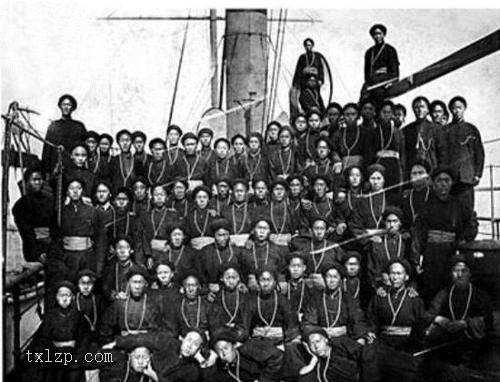Gan Bo, an old photo of Wenchuan, Sichuan in 1917; David· Sidney&middlet; David&middlet; Gamble (1890-1968) is an American social economist, humanist and famous photographer. During his five trips between China and the United States between 1908 and 1932, he took a lot of precious photos during his travels in western China. This group of photos was taken by him in Kaifeng, Henan Province between 1917 and 1919
Wenchuan County is located in the northwest of Sichuan Province, in the northwest plateau of Sichuan Province and in the southeast of Aba Tibetan and Qiang Autonomous Prefecture; The hometown of Dayu, the home of pandas, and the health care of Wenchuan” It is one of the four Qiang inhabited counties in China and one of the first batch in Sichuan Province; Tianfu Tourist County” One of them is the birthplace of Dayu, the ancestor of China, and a place where Tibetan, Qiang, Hui, Han and other ethnic groups converge
Since the Han Dynasty, the Wenjiang River and Mianjiang River (s ī)、 Wenchuan and Wenchuan are named after the Minjiang River in the territory. According to the Annals of Yuanhe County, Wenchuan County“ Because the water in West Timor is called”. Gu“ Wen&rdquo& ldquo; Min” General, so Minjiang River is also known as Wenjiang River
1917年四川汶川老照片 甘博摄
西德尼·戴维·甘博(Sidney·David·Gamble,1890年-1968年)是美国社会经济学家,人道主义者和著名摄影家。他在1908-1932年间五次往返中美之间,在中国西部地区游历期间,拍下了大量的珍贵照片。本组照片就是他在1917年-1919年之间在河南开封地区拍摄。
汶川县地处四川省西北部,居川西北高原和阿坝藏族羌族自治州东南部,有“大禹故里、熊猫家园、康养汶川”之美誉,是全国四个羌族聚居县之一,四川省首批“天府旅游名县”之一,是华夏始祖大禹的出生地,是藏、羌、回、汉等各族群众交汇融合的地带。
自汉代以来所设汶江、绵虒(sī)、汶山、汶川等建置皆以境内岷江得名,据《元和郡县志》载:汶川县“因县西汶水为名”。古“汶”、“岷”通用,故岷江亦读作汶江。
![图片[1]-Gan Bo, an old photo of Wenchuan, Sichuan in 1917-China Archive](https://chinaarchive.net/photo/republic-of-china/1-200222160016-50.jpg)
汶川文庙的檑星门,门前还一座小石桥。
![图片[2]-Gan Bo, an old photo of Wenchuan, Sichuan in 1917-China Archive](https://chinaarchive.net/photo/republic-of-china/1-200222160016.jpg)
文庙虽然破旧不堪,但是这座魁星楼保存完好特别显眼,外面是万仞墙。
![图片[3]-Gan Bo, an old photo of Wenchuan, Sichuan in 1917-China Archive](https://chinaarchive.net/photo/republic-of-china/1-200222160017.jpg)
当地一个小小的土地庙,供奉着土地奶奶和土地爷爷
![图片[4]-Gan Bo, an old photo of Wenchuan, Sichuan in 1917-China Archive](https://chinaarchive.net/photo/republic-of-china/1-200222160013-50.jpg)
俯瞰绵虒镇(老汶川县治所在)文庙,照片可以看见文庙宫墙万仞影壁里古树参天,棂星门巍峨的建筑群。
![图片[5]-Gan Bo, an old photo of Wenchuan, Sichuan in 1917-China Archive](https://chinaarchive.net/photo/republic-of-china/1-200222160013-51.jpg)
羌寨
![图片[6]-Gan Bo, an old photo of Wenchuan, Sichuan in 1917-China Archive](https://chinaarchive.net/photo/republic-of-china/1-200222160015-50.jpg)
桃关到汶川的剃头匠。这是典型的剃头挑子和剃头匠,一头是烧热水的炉灶和金属水盆,一头是顾客的坐凳。
![图片[7]-Gan Bo, an old photo of Wenchuan, Sichuan in 1917-China Archive](https://chinaarchive.net/photo/republic-of-china/1-200222160013.jpg)
第二十三世瓦寺土司索代庚和他时年13岁的儿子索观澐在土司官寨拍的合影。
![图片[8]-Gan Bo, an old photo of Wenchuan, Sichuan in 1917-China Archive](https://chinaarchive.net/photo/republic-of-china/1-200222160014.jpg)
瓦寺土司索代庚和他时年13岁的儿子
![图片[9]-Gan Bo, an old photo of Wenchuan, Sichuan in 1917-China Archive](https://chinaarchive.net/photo/republic-of-china/1-200222160014-50.jpg)
瓦寺土司索代庚和他时年13岁的儿子
![图片[10]-Gan Bo, an old photo of Wenchuan, Sichuan in 1917-China Archive](https://chinaarchive.net/photo/republic-of-china/1-200222160017-50.jpg)
中间的索索代庚土司头顶一顶瓜皮小帽,衣着长袍和斜襟丝绸马褂,下穿元宝布鞋,俨然是清末民初富贵汉人男子的打扮。
![图片[11]-Gan Bo, an old photo of Wenchuan, Sichuan in 1917-China Archive](https://chinaarchive.net/photo/republic-of-china/1-2002221A029.jpg)
瓦寺土司官寨
汶川瓦寺土司官寨位于四川省汶川县玉龙乡涂禹山村内,始建於明代中期,为城堡式。公署位於城堡中後部偏右侧,四周为管家、译师、差役、仆人及其家属的住房,现存官寨建筑除公署前厅为明代修建外,馀皆为清代建筑。该官寨为四川境内现存唯一的明代城堡式土司官寨。
![图片[12]-Gan Bo, an old photo of Wenchuan, Sichuan in 1917-China Archive](https://chinaarchive.net/photo/republic-of-china/1-2002221A030.jpg)
瓦寺土司官寨
![图片[13]-Gan Bo, an old photo of Wenchuan, Sichuan in 1917-China Archive](https://chinaarchive.net/photo/republic-of-china/1-2002221A031.jpg)
瓦寺土司官寨
城堡坐北向南,平面呈长方形,南北长90米,东西宽68米。现存东、北、西三面墙,南墙被毁而仅存山门。墙为片石修砌以泥作粘合料,用石灰加糯米汁勾缝。墙厚1米,高7米。北城门为券拱顶,高3.4米,宽2.4米,进深1.7米;东、西墙无城门;
![图片[14]-Gan Bo, an old photo of Wenchuan, Sichuan in 1917-China Archive](https://chinaarchive.net/photo/republic-of-china/1-2002221A031-50.jpg)
瓦寺土司官寨
![图片[15]-Gan Bo, an old photo of Wenchuan, Sichuan in 1917-China Archive](https://chinaarchive.net/photo/republic-of-china/1-2002221A030-50.jpg)
瓦寺土司官寨中的仆人



![[Qing Dynasty] British female painter—Elizabeth Keith, using woodblock prints to record China from the late Qing Dynasty to the early Republic of China—1915-China Archive](https://chinaarchive.net/wp-content/uploads/2022/11/image-191x300.png)

